The Model 44 is a hand-built monoplane air racer from the early 1930s, winning several trophies. Powered by a Pratt & Whitney Wasp Jr. radial engine rated for 500 horsepower.
Two variations are included, the vintage 1934 racer and a modern replica.
Liveries
There were four model 44s built by the Wedell-Williams company but one was destroyed in a crash and never raced. The other ships, scarlet and black Miss Patterson #44, white and black Miss New Orleans #92, and Roscoe Turner's Gilmore Red Lion, #121, raced in the Thompson Trophy and Bendix Trophy.
SU10 Compatible, VR Compatible
Installation
Simply unzip and copy the sal1800-wedell-williams-racer folder into your Community folder
Version 1.20 Release Notes - October, 2022
New modern replica variation
Improved sounds - Startup and shutdown
Improved cold start
Vintage 1934 Racer
This is the original, bare-bones racing variation. No electrics and very basic instruments. The large fuel tank, compass and chronograph are for the long distance cross country race. Reduce the fuel quantity to keep the aircraft light when doing local flights.
Modern Replica
This replica is so close to the original plans, its flight model is nearly identical. It comes equipped with modern instruments, lights, radio and transponder to make it more comfortable to fly in today's world. The fuel capacity is less than the 1934 variation. In addition, this has a tailwheel instead of a tail skid.
Pylon Racing
The Model 44s were very competitive at the National Air races during the 1931-1934 timeframe, setting world speed records.
Transcontinental Races
The Wedell-Williams Model 44 participated in several transcontinental races, setting the world speed records.
Due to the range of the 180 gallon main fuel tank, you can fly at speeds over 200 knots for more than 1,800 miles without refueling. Navigation during the 1930s would have been only by charts, compass and visual landmarks.
Acrobatics
This aircraft isn't really rated for aerobatics. But it will be most responsive around 140kts. As you go faster the controls get stiffer.
Brakes (Vintage only)
There is no parking brake and the engine is powerful enough at idle to pull you forward. So press the wheel brakes when you click Fly on the runway. If you are stopped, you can engage wheel chocks from the card in the cockpit or with the standard parking brake key (default "B").
Trimming
I recommend that you have buttons assigned to elevator, ailerion and rudder trim because this plane does require trimming all surfaces for a stable flight.
Startup Procedure
The vintage Model 44 does not feature an electric starter, it can only be started via hand pulling the prop. This is simulated by an invisible "ground crew" that can be signaled via the Ground Crew Instructions card in the cockpit. The pilot needs to switch on both magneto switches and then click the spot on the instruction card. Prior to starting, the pilot should apply the wheel brakes or set the wheel chocks. For the modern version: battery on, fuel on, magnetos on, press starter.
Taxi Procedure
Due to the steep ground angle and large engine cowl, forward visibility during taxi is severely limited. It is recommended to proceed slowly and use "S-turns" to maintain visibility.
Takeoff Procedure
After lining up on the runway centerline, glance to each side to establish a view of the runway edges. You will use this to gauge your position down the center of the runway.
Due to the high thrust and torque of the engine, you must increase the throttle slowly or risk an unintended turn. 15-17 inches of manifold pressure is adequate to start the takeoff roll. Once sufficient speed for the rudder to begin to have effect, you can advance the throttle to above 20 inches of manifold pressure. Liftoff should occur before 100 knots indicated.
Landing Procedure
Due to the limited forward visibility, you should adopt a modified approach. You can crab the ship and use side slip to keep the runway visible during approach. Alternatively, you could fly a close pattern where the base and final turns are rounded off. This allows you to maintain sight of the runway until crossing the threshold.
In both cases, the last moments prior to touchdown will have you with zero forward visibility. Look out the sides to maintain equal distance between the sides of the runway.
Maintain a high angle of attack to bleed off speed. The braking is intentionally weak, so engage the brakes early and apply increasing backpressure to the stick to avoid nose-over.
As the speed decreases, the tail skid will contact the ground. This will provide additional braking force.
Fuel Gauge (Vintage)
There is one 180 gallon fuel tank. You can read the level with the sight gauge tube mounted to the tank just behind the compass. The level line will begin to appear around 70 gallons remaining. The line disappears behind the tubing frame at around 27 gallons remaining. Fuel burn in cruise is around 30 gallons per hour.
Chronograph
By default, the chronograph will show the local time. Clicking on the face of the chronograph will toggle between time mode and stopwatch mode. In Stopwatch mode, clicking the top stem will start and stop the timer. When stopped, click the reset button to reset the stopwatch back to zero. The large dial is seconds, the smaller upper dial displays minutes and the smaller lower dial displays hours.
Grid Compass
The large compass at the lower section of the panel is a grid compass. The outer ring can be rotated my the pilot after the locking mechanism has been released. The "spider" inside the compass will always point toward magnetic North with the arm that has a cross at the end. The other arms indicate East and West.
To use this instrument for navigation, rotate the outer ring until your desired course is lined up with the lubber line at the top of the dial. When the pointers are within the white painted grid lines, the aircraft heading is on the selected course.
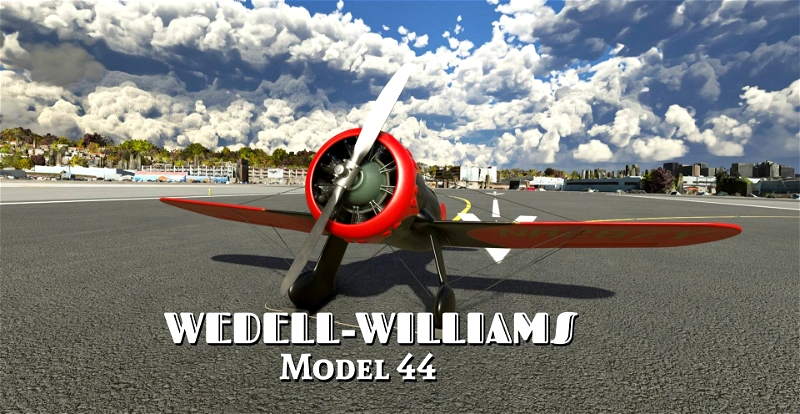
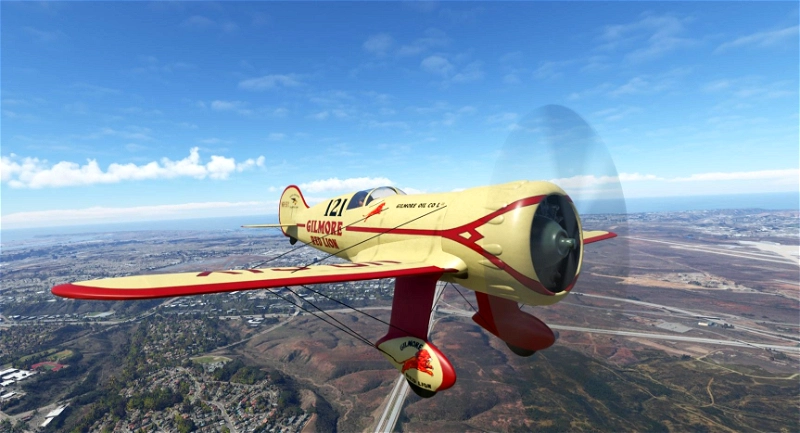
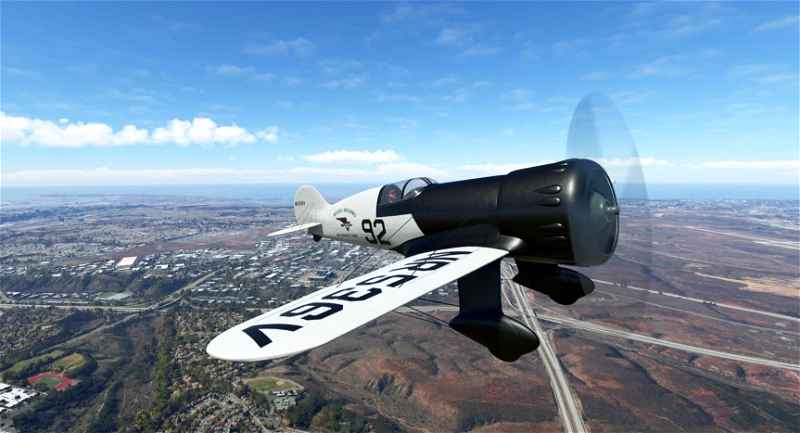
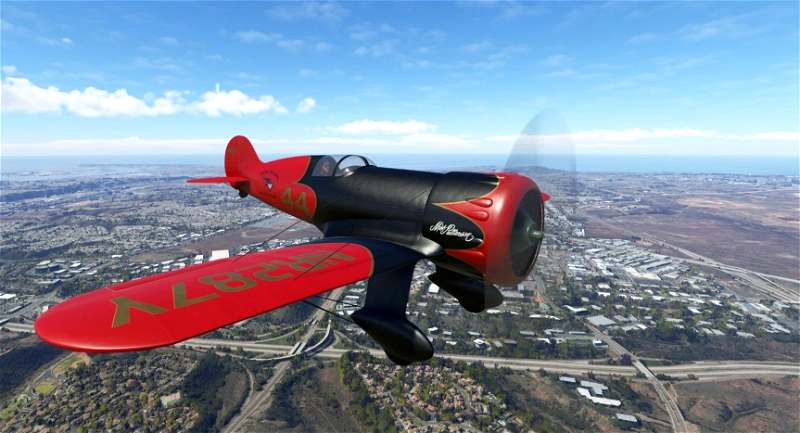
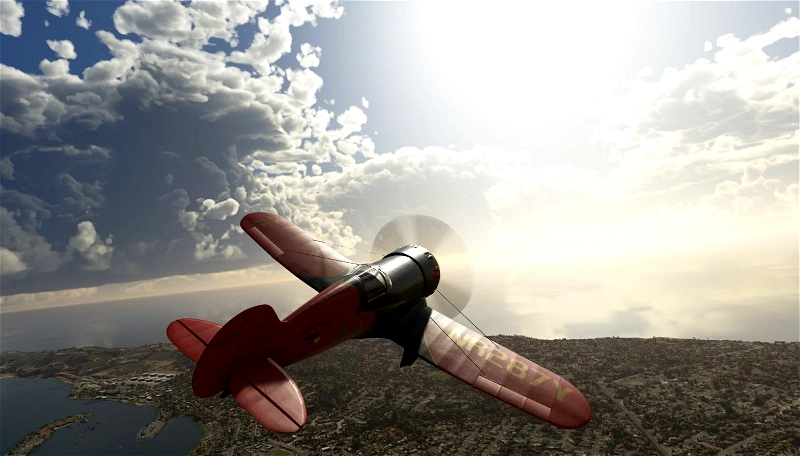
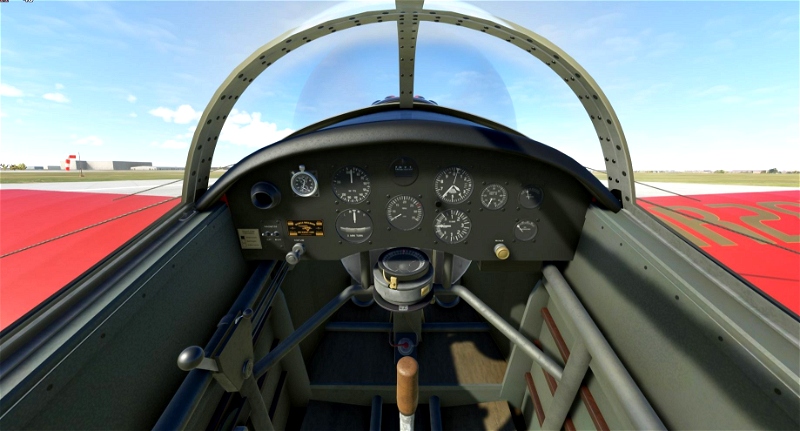
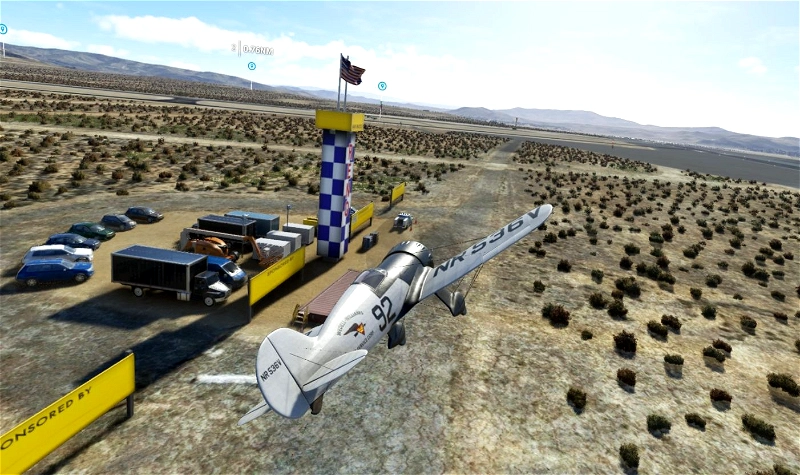
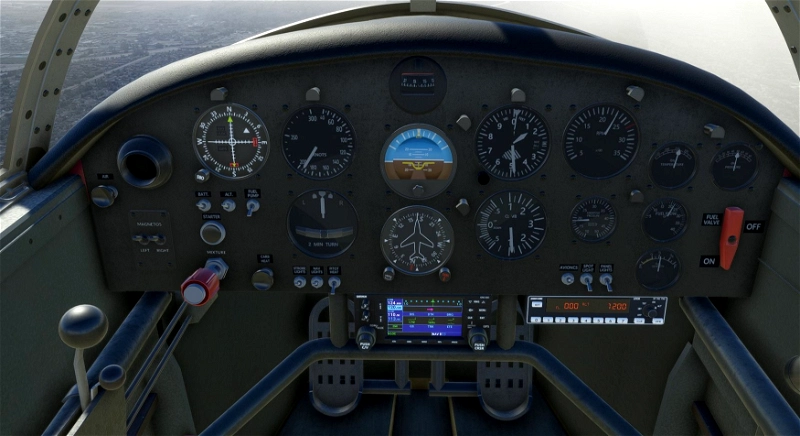

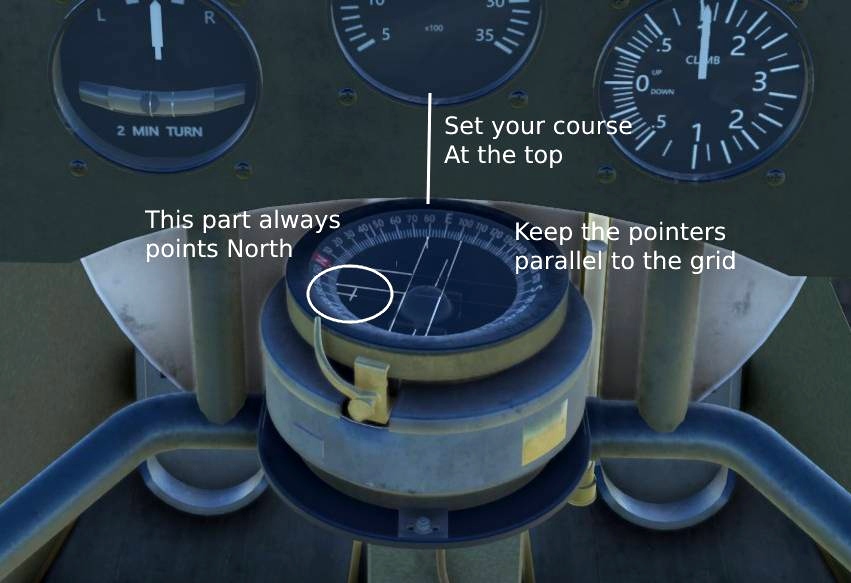




Thank you! I really enjoy this vintage beauty. It's my sunset cruiser. Plenty of power. Handles like it should. Not too squirrely on takeoff. Lands well. No flaps or landing gear levers to worry about. The engine sounds are what really does it for me though. Amazing. And the canopy can be removed for stunning open air views in VR. The Brown B-2 Air Racer "Miss Los Angeles" is another equally excellent vintage freeware aircraft from this developer, part of the Fantasy of Flight museum at FA08 (links below)
https://flightsim.to/file/46718/brown-b-2-air-racer
https://flightsim.to/file/16471/fantasy-of-flight-fa08
Cheers!
10 months ago
timoteo
So a Model 44 appeared on Marketplace today! Is it a version of this one, or is that a parallel effort by someone else? Just curious. If you did a payware version, I'd be happy to support you by buying it because you've done a couple of epic awesome freeware planes. But if that's someone else doing the same plane, yours is already awesome. 😊
11 months ago
So the marketplace version is by another developer but obviously based on this project. I make my planes open source, so this is perfectly fine with me and also nice that someone else did all the work to get it into the Marketplace.
Purchase the Marketplace version only if you want it for what it is but not if it's only to reward me. I get more than enough reward just seeing people enjoy this plane.
11 months ago
sal1800
DennyAtkin
What is the location, of the scenery, do you have a POI, for it, or longitude and latitude for it, thanks?
12 months ago
Reno? This is the scenery I use: https://flightsim.to/file/11837/reno-stead-airport-krts-reno-air-races
12 months ago
sal1800
smoothflyer
Works perfectly and looks really great.
Both variants are really great.
Thanks for that.
1 years ago
Quassel89
A great racing aircraft superbly done, the 3 liveries are top notch, the flight model is challenging. Thanks for this masterpiece!
1 years ago
fStopper
What an amazing work...!!! Thanks for sharing it with all...!!!
I really appreciate you are giving us the option to choose vintage and modern avionics, makes it even better.
2 years ago
Danko05
VERY KOOL!!! Really appreciate the inclusion of the UV's ESPECIALLY the choice of Prop Blurs! Wish more developers would do this!
2 years ago
AIRPAC1
Many thanks!!!
2 years ago
Vizipok
IT HAS NO WORKING RADIO IT SAYS TURN POWER ON TO USE RDIOM. UM YOU CAN"T!!!!! hOW DO YOU TALK TO ATC??
2 years ago
Why shouting.... :-(
2 years ago
dgio
bigrican5270
I love it!
2 years ago
USER1000
Thanks! This is a terrific gift to the community. So much fun to fly and a handful to land. This is payware quality.
2 years ago
Fredshifty
Absolutely beautiful! Flies well and is a great experience in VR. Better than a lot of payware. Thanks for all the time and effort that went into this and for sharing it with the community.
2 years ago
billythebassman
I thought this plane was cool. I was wrong! It is Awesome! https://youtu.be/sUJCr9LEEmU
2 years ago
Solinus
Nicely done!
A couple of things, the rudder pedal animation seems to be reversed. Left pedal should go in for left rudder (unless this one has something unique to it).
When shutting down the engine the sound seems 'abrupt', with a bit of a silent pause before playing the shutdown sound.
But this is quite a fun machine. We warned everyone, it doesn't like to recover from a spin!
2 years ago
Parorng
Awesome plane! Real joy to fly! I am looking forward to future development on this one. I like it the way it is already, can't wait to see the improvements! Did a review and I hope it gets you more downloads! Thanks for developing this one!! https://youtu.be/onLLVb7Dl58
2 years ago
Cool video. It's nice to see other pilots flying it.
The chronograph starts in local time mode. Clicking the face switches to stopwatch mode. It's useful if you want to try cross country navigation by pilotage!
A new variant, the modern replica, is in progress. I don't have a release date yet, but I'll finish it up soon.
2 years ago
sal1800
Solinus